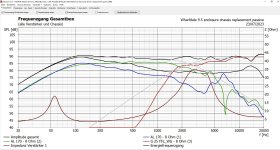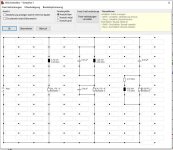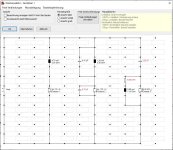Do you mean without a crossover at all? No. About any speaker I can think of needs some kind of level correction at certain frequencies and multi-way systems like this need crossovers to feed the right frequencies to the right drivers.
Crossovers can be hard-wired (e.g. glue the components on a piece of board and connect them with wires) or mounted on a predesigned pcb (printed circuit board). The lattter is tho more fancy one, but the former works just as well.
Crossovers can be hard-wired (e.g. glue the components on a piece of board and connect them with wires) or mounted on a predesigned pcb (printed circuit board). The lattter is tho more fancy one, but the former works just as well.
Hi itamar2312, the crossover design for the first quick shot as of a kind of proof of concept is active, not passive. The dome tweeter with the waveguide became a 2500 Hz Q=058 2nd order HP and three PEQs, the mid-bass woofer was a little bit tricky to be brought to the Bessel 2nd order at 2500 Hz target function because of the massive breakup above the crossover frequency. The 2nd woofer that runs together with the mid-bass for the 2 and a half way approach like the original Wharfdale model needs only a LP first order at 300 Hz. So for the woofer it is easy to use a coil for the passive crossover and run the design semi active 2 way and not completely active 3way. Both woofers run in a closed box with some PEQ about the resonance frequency for bass, but this EQ depends much more from the room where the speaker are used and the position, free, wall, corner. I like the idea to keep the old cabinet from a sustainability perspective. I can give it a try to make a first quick shot with a passive crossover if you want, but in the mean time there are some cheaper devices available for at least the semi activation with two ways that may be considered first.
Last edited:
Hello friend.BoxSim has an optimizer for passive crossovers, here the outcome, but you have to play around with this on your own if you want to get a first feeling for the simulation program.
View attachment 1195803View attachment 1195804
I downloaded the program, Thanks to you I accomplished to understand, pretty much, what I was seeing.
I think it'll be a good try to buy these drivers (4 X AL170 & 2 G 25 FFL) for 550 euros include shipping.
I sent a mail to Visaton and asked if they sell a similar crossover chip to the last one you attached. I'll update.
I can also head to a professional audio man who'll make it for me, with measuring. I already got a recommendation on someone.
Short time you maybe get an improved speaker over what you have now.
Long term it's a waste of money. (no resale value, quite some time effort for something that is no solution to the problem)
But if you like to build stuff and want to learn (and it seems you could learn a lot about speakers ;-)) and don't mind the extra money - building something is always a great experience!
Long term it's a waste of money. (no resale value, quite some time effort for something that is no solution to the problem)
But if you like to build stuff and want to learn (and it seems you could learn a lot about speakers ;-)) and don't mind the extra money - building something is always a great experience!
I believe BoxSim does not calculate the power response, which is probably the best simulated indication of how a speaker sounds in reality.
Honestly, I think you risk to spend a lot of money and work for something that may be worse than what you already have. Designing good loudspeakers is not a walk in the park.
There are some threads here on diyAudio that provide an introduction to designing your first speaker. I also recommend reading good old books about the subject.
Honestly, I think you risk to spend a lot of money and work for something that may be worse than what you already have. Designing good loudspeakers is not a walk in the park.
There are some threads here on diyAudio that provide an introduction to designing your first speaker. I also recommend reading good old books about the subject.
It does; that's the (in translation) Energy Frequency Response curve.I believe BoxSim does not calculate the power response, which is probably the best simulated indication of how a speaker sounds in reality.
Agreed -without any offense intended to anybody or the stellar work they've put in here, but I suspect 'treading water' is going to be a likely outcome, especially since this is simulated only rather than with measured in-box data. Boxsim is fairly good at this, but in the circumstances, I'd still be inclined to simply sell off the Diamonds & buy a well designed studio speaker that's more in line with the requirements.Honestly, I think you risk to spend a lot of money and work for something that may be worse than what you already have. Designing good loudspeakers is not a walk in the park.
Ladies and gentlemen,
i agree completely with the concerns about building a speaker based on one simulation posted here. It was intended only as a first real quick shot to the first input of the thread opener asking specifically for a replacement of the drivers in an existing cabinet. I am still waiting for the super pro's here in the forum that should be able to post some more accurate simulations with VituixCAD, i haven't seen any of those so far. Frankly speaking it would help me a lot to speed up my own learning curve for this program that has as far as i known with my try a few years ago some pitfalls and caveats that makes it at least more difficult to get out a first good simulation than with BoxSim. Especially with the 2 way active approach like the most studio monitors does nowadays this could be much more satisfying than to sell the old speakers and buy a pair of new ones. If i check the prices for something like a pair of small near field monitors plus subwoofer this will be hard to beat for the cost performance ratio, but there is no fun in that and the forum here is still called diyAudio and not buy a pair of studio monitors with a subwoofer forum. For accurate reviews of what you can get out of the market i have to recommend the thread opener to create an account here: https://www.audiosciencereview.com/forum/index.php
i agree completely with the concerns about building a speaker based on one simulation posted here. It was intended only as a first real quick shot to the first input of the thread opener asking specifically for a replacement of the drivers in an existing cabinet. I am still waiting for the super pro's here in the forum that should be able to post some more accurate simulations with VituixCAD, i haven't seen any of those so far. Frankly speaking it would help me a lot to speed up my own learning curve for this program that has as far as i known with my try a few years ago some pitfalls and caveats that makes it at least more difficult to get out a first good simulation than with BoxSim. Especially with the 2 way active approach like the most studio monitors does nowadays this could be much more satisfying than to sell the old speakers and buy a pair of new ones. If i check the prices for something like a pair of small near field monitors plus subwoofer this will be hard to beat for the cost performance ratio, but there is no fun in that and the forum here is still called diyAudio and not buy a pair of studio monitors with a subwoofer forum. For accurate reviews of what you can get out of the market i have to recommend the thread opener to create an account here: https://www.audiosciencereview.com/forum/index.php
Last edited:
Sorry for that, i have to continue in a new thread due to the 30 minutes timeout.
One additional comment to Visaton:
they do not have the speakers with the best cost to performance ratio but they have invested a lot of time with the measurements in one of the most expensive anechoic chambers in whole Europe.
In the actual BoxSim version they have measurement files for their own drivers with 19 measurements in one file for the on axis and off axis measurements in 5 degree steps. Unfortunately they use a proprietary binary format for this, this is of course a marketing decision to have an advantage for their own drivers, they need to earn money, they are no charity organization.
To do this in VituixCAD you need only for the measurements as such more a whole week that a few hours, it is a tedious work.
One additional comment to Visaton:
they do not have the speakers with the best cost to performance ratio but they have invested a lot of time with the measurements in one of the most expensive anechoic chambers in whole Europe.
In the actual BoxSim version they have measurement files for their own drivers with 19 measurements in one file for the on axis and off axis measurements in 5 degree steps. Unfortunately they use a proprietary binary format for this, this is of course a marketing decision to have an advantage for their own drivers, they need to earn money, they are no charity organization.
To do this in VituixCAD you need only for the measurements as such more a whole week that a few hours, it is a tedious work.
Last edited:
Agreed on the care that Visaton has taken for Boxsim. Especially with their own measurements simulations are pretty spot on and if you like to use your own, results can be pretty reliable too.
Few things on the proposed X-over, I would also damp the cone resonance of the lower AL170. Now it’s only 10dB or so under reference level. The output of the lower one declines too slow at higher frequencies too. The tweeter high pass doesn’t match the midwoofer low pass that good. Furthermore a waveguide (Visaton WG148) would bring a real improvement. Visaton offers measurements of a few tweeters with it in Boxsim.
Few things on the proposed X-over, I would also damp the cone resonance of the lower AL170. Now it’s only 10dB or so under reference level. The output of the lower one declines too slow at higher frequencies too. The tweeter high pass doesn’t match the midwoofer low pass that good. Furthermore a waveguide (Visaton WG148) would bring a real improvement. Visaton offers measurements of a few tweeters with it in Boxsim.
Here we go:
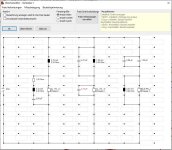
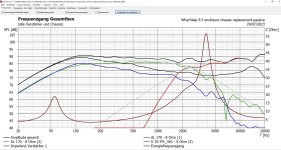
For the peak in the impedance curve at about 3.9 kHz there is a good chance to add an impedance correction RLC circuit, depends on the amp used.
I have used the G25_FFL_WG file for the tweeter, this is the one with the waveguide. With the series capacitor for the tweeter there will be probably the need to use a matched pair for the stereo setup, the value decide about the SPL of the tweeter like for a compression driver tweeter.


For the peak in the impedance curve at about 3.9 kHz there is a good chance to add an impedance correction RLC circuit, depends on the amp used.
I have used the G25_FFL_WG file for the tweeter, this is the one with the waveguide. With the series capacitor for the tweeter there will be probably the need to use a matched pair for the stereo setup, the value decide about the SPL of the tweeter like for a compression driver tweeter.
Attachments
Last edited:
That’s most likely because the waveguide shows quite some peaking >20 degrees off axis above 10k. Nothing to worry about, almost any wall finish absorbs such frequencies big time so effectively you won’t see any sound power increase taking direct and indirect field together.
Hi IamJF, i also believe it is a high frequencies no more constant directivity issue of the dome tweeter with a waveguide but no phase plug.
Actually that's a behaviour which would often be beneficial to overdampened rooms but is nearly impossible to achieve - at least with a dome with no massive breakup. So I cot curious immediately ;-)
A bigger on axis chancellation could be the reason but of course that's not what we want from a monitor speaker.
A bigger on axis chancellation could be the reason but of course that's not what we want from a monitor speaker.
These small PMCs ... are nice speakers but by no means reliable monitors.
Do yourself a favour - sell your gear and get a pair of KH120ii + MA1. That's probably a stretch of your budget but sets the baseline for a reliable monitoring situation.
Don't forget the room, this is something where you can get pretty far with DIY absorbers.
And when you add a KH750 subwoofer later you have a nice, precise and reliable full range monitor solution starting at 20Hz.
This is the proper advice, OP you should heed these words.
Second speaker doesn't load most images, but none of these are going to compete with offerings from neumann or genelec, or really any other well designed waveguided tweeter speaker. The difference between your standard dispersion mismatched two way and one that handles dispersion properly is very, very obvious once you start to try and mix on them. Those are also quite a bit of effort to not even match what a $400/pair kali lp6 can do.
- Home
- Loudspeakers
- Multi-Way
- Searching for three recommended studio-monitors drivers (Bass, Midrange, Tweeter)
